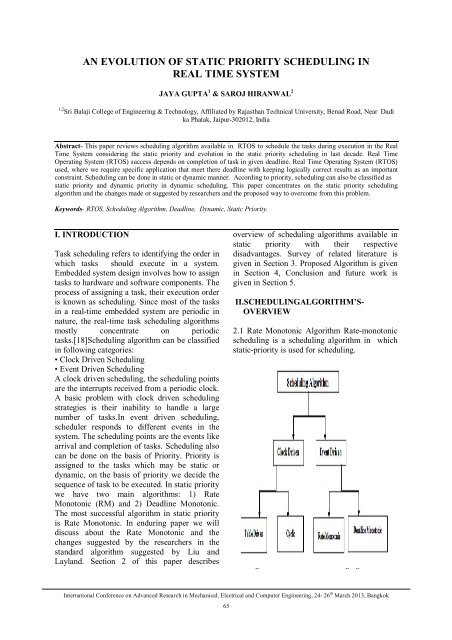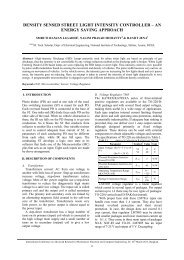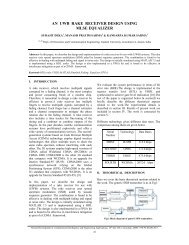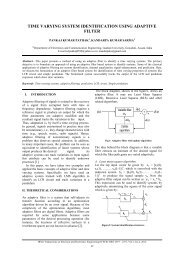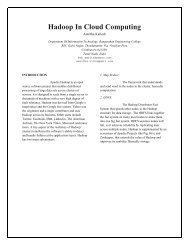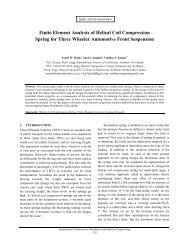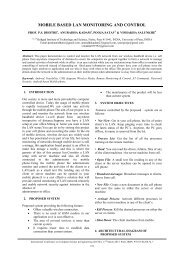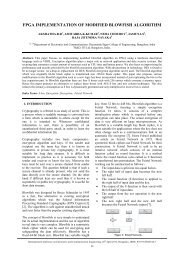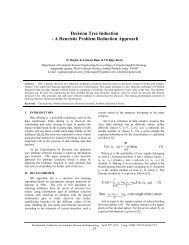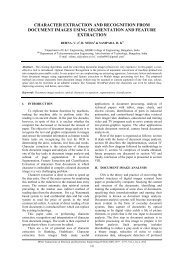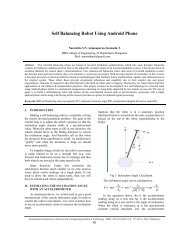an evolution of static priority scheduling in real time ... - IRNet Explore
an evolution of static priority scheduling in real time ... - IRNet Explore
an evolution of static priority scheduling in real time ... - IRNet Explore
You also want an ePaper? Increase the reach of your titles
YUMPU automatically turns print PDFs into web optimized ePapers that Google loves.
An <strong>evolution</strong> <strong>of</strong> <strong>static</strong> <strong>priority</strong> <strong>schedul<strong>in</strong>g</strong> <strong>in</strong> Real <strong>time</strong> systemAN EVOLUTION OF STATIC PRIORITY SCHEDULING INREAL TIME SYSTEMJAYA GUPTA 1 & SAROJ HIRANWAL 21,2 Sri Balaji College <strong>of</strong> Eng<strong>in</strong>eer<strong>in</strong>g & Technology, Affiliated by Rajasth<strong>an</strong> Technical University, Benad Road, Near Dadika Phatak, Jaipur-302012, IndiaAbstract- This paper reviews <strong>schedul<strong>in</strong>g</strong> algorithm available <strong>in</strong> RTOS to schedule the tasks dur<strong>in</strong>g execution <strong>in</strong> the RealTime System consider<strong>in</strong>g the <strong>static</strong> <strong>priority</strong> <strong>an</strong>d <strong>evolution</strong> <strong>in</strong> the <strong>static</strong> <strong>priority</strong> <strong>schedul<strong>in</strong>g</strong> <strong>in</strong> last decade. Real TimeOperat<strong>in</strong>g System (RTOS) success depends on completion <strong>of</strong> task <strong>in</strong> given deadl<strong>in</strong>e. Real Time Operat<strong>in</strong>g System (RTOS)used, where we require specific application that meet there deadl<strong>in</strong>e with keep<strong>in</strong>g logically correct results as <strong>an</strong> import<strong>an</strong>tconstra<strong>in</strong>t. Schedul<strong>in</strong>g c<strong>an</strong> be done <strong>in</strong> <strong>static</strong> or dynamic m<strong>an</strong>ner. Accord<strong>in</strong>g to <strong>priority</strong>, <strong>schedul<strong>in</strong>g</strong> c<strong>an</strong> also be classified as<strong>static</strong> <strong>priority</strong> <strong>an</strong>d dynamic <strong>priority</strong> <strong>in</strong> dynamic <strong>schedul<strong>in</strong>g</strong>. This paper concentrates on the <strong>static</strong> <strong>priority</strong> <strong>schedul<strong>in</strong>g</strong>algorithm <strong>an</strong>d the ch<strong>an</strong>ges made or suggested by researchers <strong>an</strong>d the proposed way to overcome from this problem.Keywords- RTOS, Schedul<strong>in</strong>g Algorithm, Deadl<strong>in</strong>e, Dynamic, Static Priority.I. INTRODUCTIONTask <strong>schedul<strong>in</strong>g</strong> refers to identify<strong>in</strong>g the order <strong>in</strong>which tasks should execute <strong>in</strong> a system.Embedded system design <strong>in</strong>volves how to assigntasks to hardware <strong>an</strong>d s<strong>of</strong>tware components. Theprocess <strong>of</strong> assign<strong>in</strong>g a task, their execution orderis known as <strong>schedul<strong>in</strong>g</strong>. S<strong>in</strong>ce most <strong>of</strong> the tasks<strong>in</strong> a <strong>real</strong>-<strong>time</strong> embedded system are periodic <strong>in</strong>nature, the <strong>real</strong>-<strong>time</strong> task <strong>schedul<strong>in</strong>g</strong> algorithmsmostly concentrate on periodictasks.[18]Schedul<strong>in</strong>g algorithm c<strong>an</strong> be classified<strong>in</strong> follow<strong>in</strong>g categories:• Clock Driven Schedul<strong>in</strong>g• Event Driven Schedul<strong>in</strong>gA clock driven <strong>schedul<strong>in</strong>g</strong>, the <strong>schedul<strong>in</strong>g</strong> po<strong>in</strong>tsare the <strong>in</strong>terrupts received from a periodic clock.A basic problem with clock driven <strong>schedul<strong>in</strong>g</strong>strategies is their <strong>in</strong>ability to h<strong>an</strong>dle a largenumber <strong>of</strong> tasks.In event driven <strong>schedul<strong>in</strong>g</strong>,scheduler responds to different events <strong>in</strong> thesystem. The <strong>schedul<strong>in</strong>g</strong> po<strong>in</strong>ts are the events likearrival <strong>an</strong>d completion <strong>of</strong> tasks. Schedul<strong>in</strong>g alsoc<strong>an</strong> be done on the basis <strong>of</strong> Priority. Priority isassigned to the tasks which may be <strong>static</strong> ordynamic, on the basis <strong>of</strong> <strong>priority</strong> we decide thesequence <strong>of</strong> task to be executed. In <strong>static</strong> <strong>priority</strong>we have two ma<strong>in</strong> algorithms: 1) RateMonotonic (RM) <strong>an</strong>d 2) Deadl<strong>in</strong>e Monotonic.The most successful algorithm <strong>in</strong> <strong>static</strong> <strong>priority</strong>is Rate Monotonic. In endur<strong>in</strong>g paper we willdiscuss about the Rate Monotonic <strong>an</strong>d thech<strong>an</strong>ges suggested by the researchers <strong>in</strong> thest<strong>an</strong>dard algorithm suggested by Liu <strong>an</strong>dLayl<strong>an</strong>d. Section 2 <strong>of</strong> this paper describesoverview <strong>of</strong> <strong>schedul<strong>in</strong>g</strong> algorithms available <strong>in</strong><strong>static</strong> <strong>priority</strong> with their respectivedisadv<strong>an</strong>tages. Survey <strong>of</strong> related literature isgiven <strong>in</strong> Section 3. Proposed Algorithm is given<strong>in</strong> Section 4, Conclusion <strong>an</strong>d future work isgiven <strong>in</strong> Section 5.II.SCHEDULINGALGORITHM’S-OVERVIEW2.1 Rate Monotonic Algorithm Rate-monotonic<strong>schedul<strong>in</strong>g</strong> is a <strong>schedul<strong>in</strong>g</strong> algorithm <strong>in</strong> which<strong>static</strong>-<strong>priority</strong> is used for <strong>schedul<strong>in</strong>g</strong>.Fig 1: Classification <strong>of</strong> Schedul<strong>in</strong>g algorithm.International Conference on Adv<strong>an</strong>ced Research <strong>in</strong> Mech<strong>an</strong>ical, Electrical <strong>an</strong>d Computer Eng<strong>in</strong>eer<strong>in</strong>g, 24- 26 th March 2013, B<strong>an</strong>gkok65
The <strong>static</strong> priorities are assigned accord<strong>in</strong>g to theperiod <strong>of</strong> the job, the shortest period job get thehighest job <strong>priority</strong> <strong>an</strong>d vice-versa.Theseoperat<strong>in</strong>g systems are generally preemptive <strong>an</strong>dhave determ<strong>in</strong>istic guar<strong>an</strong>tees with regard toresponse <strong>time</strong>s. [1, 3]A simple version <strong>of</strong> ratemonotonic<strong>an</strong>alysis assumes that threads havethe follow<strong>in</strong>g properties:1. All processes run on a s<strong>in</strong>gle CPU i.e. noparallel task execution.2. Determ<strong>in</strong>istic deadl<strong>in</strong>es are exactly equal toperiods3. Static priorities (the task with the highest<strong>static</strong> <strong>priority</strong> that is run able immediatelypreempts all other tasks)4. Tasks are <strong>in</strong>dependent from each other.5. Context switch <strong>time</strong>s have no impact on theperform<strong>an</strong>ce.Liu & Layl<strong>an</strong>d (1973) proved that for a set <strong>of</strong> nperiodic tasks with unique periods, a feasibleschedule that will always meet deadl<strong>in</strong>es exists ifthe CPU utilization is below a specific bound(depend<strong>in</strong>g on the number <strong>of</strong> tasks). [21] Theschedulability test for RMS is:An <strong>evolution</strong> <strong>of</strong> <strong>static</strong> <strong>priority</strong> <strong>schedul<strong>in</strong>g</strong> <strong>in</strong> Real <strong>time</strong> systemversa.This <strong>priority</strong> policy is optimal for a set <strong>of</strong>periodic or sporadic tasks with follow<strong>in</strong>gconditions:1. All tasks deadl<strong>in</strong>es should less th<strong>an</strong> or equalto their m<strong>in</strong>imum <strong>in</strong>ter-arrival <strong>time</strong>s (orperiods).2. All tasks have worst-case execution <strong>time</strong>s(WCET) that are less th<strong>an</strong> or equal to theirdeadl<strong>in</strong>es.3. All tasks are <strong>in</strong>dependent <strong>an</strong>d they do notaffect the work<strong>in</strong>g <strong>of</strong> other by block<strong>in</strong>g.4. No task voluntarily suspends itself.5. Dur<strong>in</strong>g execution there could be <strong>an</strong> <strong>in</strong>st<strong>an</strong>toccur when all the task goes ready toexecute that <strong>in</strong>st<strong>an</strong>t is known as critical<strong>in</strong>st<strong>an</strong>t.6. Schedul<strong>in</strong>g overheads (switch<strong>in</strong>g from onetask to <strong>an</strong>other) are zero.7. All tasks have zero release jitter (the <strong>time</strong>from the task arriv<strong>in</strong>g to it becom<strong>in</strong>g readyto execute).[16] Drawback:• It is less predictable as task dependsupon the deadl<strong>in</strong>es.• It is less controllable.III. RELATED WORK DONEWhere Ci is the computation <strong>time</strong>, Ti is therelease period (with deadl<strong>in</strong>e one period later),<strong>an</strong>d n is the number <strong>of</strong> processes to bescheduled.[15,18,20]Drawbacks:• It is difficult to h<strong>an</strong>dle aperiodic <strong>an</strong>d sporadictasks.• It is not optimal if deadl<strong>in</strong>e <strong>an</strong>d period <strong>of</strong> thetask are differ<strong>in</strong>g.2.2 Deadl<strong>in</strong>e MonotonicDeadl<strong>in</strong>e-monotonic <strong>schedul<strong>in</strong>g</strong> is a <strong>schedul<strong>in</strong>g</strong>algorithm <strong>in</strong> which <strong>static</strong>-<strong>priority</strong> is used for<strong>schedul<strong>in</strong>g</strong>. The <strong>static</strong> priorities are assignedaccord<strong>in</strong>g to the deadl<strong>in</strong>e <strong>of</strong> the job, the shortestdeadl<strong>in</strong>e job get the highest job <strong>priority</strong> <strong>an</strong>d ice-S<strong>in</strong>ce 1973, when Liu <strong>an</strong>d Layl<strong>an</strong>d proved thatfor a set <strong>of</strong> n periodic tasks with unique periods,a feasible schedule that will always meetdeadl<strong>in</strong>es exists if the CPU utilization is below aspecific bound. In field <strong>of</strong> <strong>static</strong> <strong>schedul<strong>in</strong>g</strong>algorithm design<strong>in</strong>g lot <strong>of</strong> research have beendone like some worked on f<strong>in</strong>d<strong>in</strong>g the optimal<strong>schedul<strong>in</strong>g</strong> algorithm, do the comparison <strong>of</strong><strong>schedul<strong>in</strong>g</strong> algorithm, try to create algorithmbetter for all type <strong>of</strong> task or suggest the ch<strong>an</strong>ges<strong>in</strong> exist<strong>in</strong>g algorithm for improvement.Maximum research done <strong>in</strong> <strong>static</strong> <strong>priority</strong><strong>schedul<strong>in</strong>g</strong> is related to Rate Monotonic, as it isthe optimal algorithm available <strong>in</strong> this<strong>schedul<strong>in</strong>g</strong> technique. Few <strong>of</strong> them areconcluded <strong>in</strong> the given below table with theirrespective years:International Conference on Adv<strong>an</strong>ced Research <strong>in</strong> Mech<strong>an</strong>ical, Electrical <strong>an</strong>d Computer Eng<strong>in</strong>eer<strong>in</strong>g, 24- 26 th March 2013, B<strong>an</strong>gkok66
An <strong>evolution</strong> <strong>of</strong> <strong>static</strong> <strong>priority</strong> <strong>schedul<strong>in</strong>g</strong> <strong>in</strong> Real <strong>time</strong> systemTable 1: Summary <strong>of</strong> different proposed algorithms for task <strong>schedul<strong>in</strong>g</strong> <strong>in</strong> <strong>real</strong> <strong>time</strong> system3.1 Limitations:International Conference on Adv<strong>an</strong>ced Research <strong>in</strong> Mech<strong>an</strong>ical, Electrical <strong>an</strong>d Computer Eng<strong>in</strong>eer<strong>in</strong>g, 24- 26 th March 2013, B<strong>an</strong>gkok67
An <strong>evolution</strong> <strong>of</strong> <strong>static</strong> <strong>priority</strong> <strong>schedul<strong>in</strong>g</strong> <strong>in</strong> Real <strong>time</strong> systemIn above created table we read about m<strong>an</strong>yalgorithms <strong>an</strong>d suggestions <strong>in</strong> exist<strong>in</strong>g algorithmpatterns. In “Modified Rate-MonotonicAlgorithm for Schedul<strong>in</strong>g Periodic Jobs withDeferred Deadl<strong>in</strong>es”, Author proposed semi<strong>static</strong><strong>priority</strong>-driven algorithm; each job isassigned two fixed priorities, the higher <strong>priority</strong>for its previous job request <strong>an</strong>d the lower <strong>priority</strong>for recent job request. When the amounts <strong>of</strong>deference are sufficiently large, jobs c<strong>an</strong> befeasibly scheduled us<strong>in</strong>g this algorithm withcondition that their total utilization is equal to orless th<strong>an</strong> one. Limitation <strong>of</strong> this algorithm is, <strong>in</strong> aspecial case modified rate-monotonic algorithmis not optimal for this case when the period ratiois larger th<strong>an</strong> two.[2]In “A Reservation-BasedAlgorithm for Schedul<strong>in</strong>g Both Periodic <strong>an</strong>dAperiodic Real-Time Tasks” author concludethat however there approach is good but not bestas there some issues could arise like: if the taskswitch<strong>in</strong>g <strong>time</strong> is not negligible, this overhead <strong>in</strong>the RB algorithm may affect the derivation. Agood <strong>schedul<strong>in</strong>g</strong> algorithm (EDF, MUF) mayimprove the probability <strong>of</strong> guar<strong>an</strong>tee<strong>in</strong>gaperiodic tasks. [5, 13] In “Modified Version <strong>of</strong>Rate-Monotonic Schedul<strong>in</strong>g Algorithm <strong>an</strong>d itsEfficiency Assessment” Author identifies specialcase <strong>of</strong> systems execution us<strong>in</strong>g RMA, for thisspecial case it was shown that least upper boundto load factor is improved. Author nameddelayed rate-monotonic algorithm. There are fewset <strong>of</strong> task that c<strong>an</strong> run safely with DRM <strong>an</strong>dbehave unsafe with RM. Due to import<strong>an</strong>ce <strong>of</strong>safety verification <strong>of</strong> <strong>real</strong>-<strong>time</strong> systems prior totheir be<strong>in</strong>g operational there is still need to makeit more efficient.[6]In “Space <strong>of</strong> Rate MonotonicSchedulability” Approach to <strong>an</strong>alyze theschedulability <strong>of</strong> periodic tasks under the RateMonotonic <strong>priority</strong> approach, such <strong>an</strong> approachallowed us to accurately decide the feasibilityregion <strong>in</strong> the space <strong>of</strong> task computation <strong>time</strong>s<strong>an</strong>d able to derive a tunable guar<strong>an</strong>tee test.Tunability property is import<strong>an</strong>t <strong>in</strong> special caseswhere perform<strong>an</strong>ce <strong>of</strong> a polynomial <strong>time</strong> test isnot adequate for achiev<strong>in</strong>g high processorutilization, <strong>an</strong>d the overhead <strong>in</strong>troduced by exacttests is too high for <strong>an</strong> on-l<strong>in</strong>e admissioncontrol. In the proposed algorithm we c<strong>an</strong><strong>in</strong>troduce different cases like when taskcomputation <strong>time</strong>s are considered as r<strong>an</strong>domvariables with known probability distribution.[10]In “Rate Monotonic SchedulabilityConditions Us<strong>in</strong>g Relative Period Ratios”, Thispaper presents a special case <strong>of</strong> RMschedulability bound as a function <strong>of</strong> z1 <strong>an</strong>d z2,the ratios <strong>of</strong> the smallest <strong>an</strong>d the largest virtualperiods to the largest period. We c<strong>an</strong> reduce thedifference between the smallest <strong>an</strong>d largest jobperiod <strong>an</strong>d a periodic task system c<strong>an</strong> beachieve a higher Rate-Monotonicschedulability. Limitation <strong>of</strong> this approach is thatthis provide good result <strong>in</strong> uniprocessor but <strong>in</strong>multiprocessor environment it still need to beexecute.[11] In ”Response Time Analysis <strong>of</strong>Asynchronous Periodic <strong>an</strong>d Sporadic TasksScheduled by a Fixed-Priority PreemptiveAlgorithm” [7]. This algorithm c<strong>an</strong> be used tostudy the schedulability <strong>of</strong> asynchronousperiodic <strong>an</strong>d sporadic tasks scheduled by a fixed<strong>priority</strong>preemptive algorithm. It c<strong>an</strong> be used to:• Dim<strong>in</strong>ish the pessimism <strong>in</strong>duced by thecritical <strong>in</strong>st<strong>an</strong>t• Allow <strong>of</strong>fset relationships• Determ<strong>in</strong>e the worst response <strong>time</strong> <strong>of</strong> eachjob– <strong>an</strong>alyze response jitter– account for missed deadl<strong>in</strong>es• Calculate the asynchronous critical <strong>in</strong>st<strong>an</strong>t– <strong>in</strong>tegrate sporadic tasks– <strong>in</strong>crease <strong>an</strong>alysis speedThe calculation <strong>of</strong> the response <strong>time</strong>s <strong>of</strong> all jobsunder a particular condition is necessary.Therefore, the proposed methods do not scalewell aga<strong>in</strong>st the number <strong>of</strong> periodic tasks,especially task sets us<strong>in</strong>g co-prime periods.In“Modified Rate-Monotonic Algorithm forSchedul<strong>in</strong>g Periodic Tasks with DifferentImport<strong>an</strong>ce <strong>in</strong> Embedded System”, Authorproposes a new <strong>schedul<strong>in</strong>g</strong> algorithm based onRM. It improves the <strong>schedul<strong>in</strong>g</strong> <strong>of</strong> long periodtasks which are import<strong>an</strong>t by add<strong>in</strong>g twoparameters, import<strong>an</strong>ce <strong>an</strong>d laxity. Authorsuggests if import<strong>an</strong>ce is higher when task laxityis zero could preempt the runn<strong>in</strong>g task. Authorsalso suggest that the algorithm could be decreasethe deadl<strong>in</strong>e-miss<strong>in</strong>g ratio <strong>of</strong> the tasks <strong>an</strong>d theCPU resource could be used more efficiently.Limitation <strong>of</strong> this algorithm is it c<strong>an</strong> use only <strong>in</strong>limited area where <strong>priority</strong> does not depends ondeadl<strong>in</strong>e or on period.[8, 15]In “Global Rate-Monotonic Schedul<strong>in</strong>g with Priority Promotion”In this paper, author presents the Rate-Monotonic until Zero Laxity (RMZL) algorithm,which applies the laxity-driven <strong>priority</strong>promotion strategy to the global Rate-Monotonicalgorithm. Authors execute the schedulabilitytest <strong>an</strong>d the tard<strong>in</strong>ess bound <strong>in</strong> the algorithm.Accord<strong>in</strong>g to author RMZL algorithm is able toInternational Conference on Adv<strong>an</strong>ced Research <strong>in</strong> Mech<strong>an</strong>ical, Electrical <strong>an</strong>d Computer Eng<strong>in</strong>eer<strong>in</strong>g, 24- 26 th March 2013, B<strong>an</strong>gkok68
execute more tasks th<strong>an</strong> the Rate-Monotonic <strong>an</strong>dthe RMUS. As per paper the RMZL algorithm iscompetitive with <strong>an</strong>d is even better for a largernumber <strong>of</strong> CPU cores th<strong>an</strong> the EDZL algorithm.Limitation <strong>of</strong> this paper is that they presentschedulability test is pessimistic, while itoutperforms the exist<strong>in</strong>g fixed-<strong>priority</strong>algorithms. There is one more issue is there howto detect the zero-laxity condition. [12, 14]In lastalgorithm “A New Schedul<strong>in</strong>g Algorithm forReal Time System” author purpose a algorithmwhich elim<strong>in</strong>ates the drawbacks <strong>of</strong> consider<strong>in</strong>g as<strong>in</strong>gle component which could be period ordeadl<strong>in</strong>e to assign the <strong>priority</strong>. This algorithmc<strong>an</strong> be implemented <strong>in</strong> <strong>real</strong> <strong>time</strong> system withcondition where period <strong>an</strong>d deadl<strong>in</strong>e doesn’tvary with <strong>time</strong>. In rate monotonic algorithm allavailable task consider as equal import<strong>an</strong>t <strong>an</strong>d<strong>priority</strong> decide by the period <strong>of</strong> the task, due towhich some unimport<strong>an</strong>t task could bescheduled before <strong>an</strong> import<strong>an</strong>t task. Deadl<strong>in</strong>emonotonic algorithm where all the tasksconsider as equal import<strong>an</strong>t <strong>an</strong>d they scheduledon the basis <strong>of</strong> deadl<strong>in</strong>es same problem couldoccur <strong>in</strong> this algorithm also. Authors proposearchitecture to overcome with this drawback bycomb<strong>in</strong><strong>in</strong>g the adv<strong>an</strong>tages <strong>of</strong> period <strong>an</strong>ddeadl<strong>in</strong>e. Percentage <strong>of</strong> weightage is provided toall the parameter <strong>an</strong>d based on their weight, a<strong>priority</strong> component calculated on the basis <strong>of</strong>which we schedule the task. Limitation <strong>of</strong> thisproposed algorithm is that, it c<strong>an</strong> beimplemented <strong>in</strong> <strong>real</strong> <strong>time</strong> system with conditionwhere period <strong>an</strong>d deadl<strong>in</strong>e doesn’t vary with<strong>time</strong>. [17,19]IV.PROPOSED ALGORITHM-ARCHITETUREAn <strong>evolution</strong> <strong>of</strong> <strong>static</strong> <strong>priority</strong> <strong>schedul<strong>in</strong>g</strong> <strong>in</strong> Real <strong>time</strong> systemthe sort<strong>in</strong>g <strong>of</strong> task will be done on the basis <strong>of</strong>this selective component.V. CONCLUSION & FUTURE WORKThis paper presents a categorized summary <strong>of</strong>work done <strong>in</strong> the area <strong>of</strong> <strong>static</strong> <strong>priority</strong> basedtask <strong>schedul<strong>in</strong>g</strong><strong>in</strong> RTOS, types <strong>of</strong> <strong>schedul<strong>in</strong>g</strong>algorithm like clock driven & event driven <strong>an</strong>dthere subclass algorithms for e.g. cyclic, tabledriven, rate monotonic, deadl<strong>in</strong>e monotonic <strong>an</strong>dtheir adv<strong>an</strong>tages <strong>an</strong>d disadv<strong>an</strong>tages . My reviewconcludes that there is no s<strong>in</strong>gle algorithmavailable which optimal for <strong>an</strong>y type <strong>of</strong> tasks,every algorithm has some f<strong>in</strong>ite limitation.Themajor challenge is, no algorithm has beensuggested such as to use one or more th<strong>an</strong> one,import<strong>an</strong>t parameters to make <strong>an</strong> equation suchthat the created algorithm could select a set <strong>of</strong>task <strong>an</strong>d do there <strong>schedul<strong>in</strong>g</strong> as no task miss thedeadl<strong>in</strong>e or make the throughput <strong>time</strong> delaym<strong>in</strong>imum. In last section we proposed <strong>an</strong>algorithm architecture us<strong>in</strong>g which we c<strong>an</strong>reduce the deadl<strong>in</strong>e miss<strong>in</strong>g <strong>time</strong>.REFERENCES:[1] John Lehoczky , Lui Sha <strong>an</strong>d Ye D<strong>in</strong>g “The RateMonotonic[2] Schedul<strong>in</strong>g Algorithm: Exact Characterization AndAverage Case Behavior” CH2803-5/89/0000/0166,1989 IEEE. Liu <strong>an</strong>d C. L. Liu“Modified Rate- Monotonic Algorithm for Schedul<strong>in</strong>gPeriodic Jobs with Deferred Deadl<strong>in</strong>es” IEEEtr<strong>an</strong>sactions on s<strong>of</strong>iware eng<strong>in</strong>eer<strong>in</strong>g, vol. 19, no. 12,december 1993[3] Krithi Ramamritham <strong>an</strong>d John A. St<strong>an</strong>kovic ”Schedul<strong>in</strong>g Algorithms <strong>an</strong>d Operat<strong>in</strong>g Systems Supportfor Real-Time Systems” proceed<strong>in</strong>gs <strong>of</strong> the IEEE, vol.82. no. I , j<strong>an</strong>uary 1994.After do<strong>in</strong>g the literature survey, we are now <strong>in</strong>condition to purpose <strong>an</strong> architecture us<strong>in</strong>g whichwe c<strong>an</strong> calculate a selective component.Selective component will take 30% weightagefrom period, 20% from deadl<strong>in</strong>e <strong>an</strong>d 50%weightage will be taken from user def<strong>in</strong>ed<strong>priority</strong>. On the basis <strong>of</strong> this selective componentnow task <strong>schedul<strong>in</strong>g</strong> we be performed, <strong>in</strong> case<strong>an</strong>y two or more task calculate the sameselective component then period will be check<strong>an</strong>d short period task will execute first. For eg.Let’s consider a task whose period is 45,deadl<strong>in</strong>e is 55 <strong>an</strong>d the user def<strong>in</strong>ed <strong>priority</strong> is 4.Now the selective component will be calculated30% <strong>of</strong> 45 + 20% <strong>of</strong> 55 + 50% <strong>of</strong> 4= 26. Now[4] John A. St<strong>an</strong>kovic, Marco Spuri hlarco Di Natale <strong>an</strong>dGiorgio C Buttazzo” Implications <strong>of</strong> ClassicalSchedul<strong>in</strong>g Results for Real-Time Systems”. 0018-9162/95,1995 IEEE.[5] K<strong>an</strong>g G. Sh<strong>in</strong> <strong>an</strong>d Yi-Chieh Ch<strong>an</strong>g ” A Reservation-Based Algorithm for Schedul<strong>in</strong>g Both Periodic <strong>an</strong>dAperiodic Real-Time Tasks”. IEEE Tr<strong>an</strong>sactions onComputers, vol. 44, no. 12, december 1995.[6] Mahmoud Naghibzadeh ” A Modified Version <strong>of</strong> Rate-Monotonic Schedul<strong>in</strong>g Algorithm <strong>an</strong>d its EfficiencyAssessment” 1530-1443/02, 2002 IEEE.[7] M<strong>an</strong>uel Cout<strong>in</strong>ho, Jos´e Ruf<strong>in</strong>o <strong>an</strong>d Carlos Almeida”Response Time Analysis <strong>of</strong> Asynchronous Periodic <strong>an</strong>dSporadic Tasks Scheduled by a Fixed-PriorityPreemptive Algorithm” 1068-3070/08, 2008 IEEE.[8] Jiwen Dong ,Y<strong>an</strong>g Zh<strong>an</strong>g “A Modified Rate-MonotonicAlgorithm for Schedul<strong>in</strong>g Periodic Tasks withInternational Conference on Adv<strong>an</strong>ced Research <strong>in</strong> Mech<strong>an</strong>ical, Electrical <strong>an</strong>d Computer Eng<strong>in</strong>eer<strong>in</strong>g, 24- 26 th March 2013, B<strong>an</strong>gkok69
An <strong>evolution</strong> <strong>of</strong> <strong>static</strong> <strong>priority</strong> <strong>schedul<strong>in</strong>g</strong> <strong>in</strong> Real <strong>time</strong> systemDifferent Import<strong>an</strong>ce <strong>in</strong> Embedded System”ICEMI’2009.International Journal <strong>of</strong> Adv<strong>an</strong>ces <strong>in</strong> Science <strong>an</strong>dTechnology, Vol. 1, No. 4, 2010.[9] Li Jie, Guo Ruifeng<strong>an</strong>d Shao Zhixi<strong>an</strong>g “The Research<strong>of</strong> Schedul<strong>in</strong>g Algorithms <strong>in</strong> Real-<strong>time</strong> System” 2010International Conference on Computer <strong>an</strong>dCommunication Technologies <strong>in</strong> AgricultureEng<strong>in</strong>eer<strong>in</strong>g.[10] Enrico B<strong>in</strong>i, Giorgio C. Buttazzo “The Space <strong>of</strong> RateMonotonic Schedulability” Proceed<strong>in</strong>gs <strong>of</strong> the 23rdIEEE Real-Time Systems Symposium (RTSS’02),1052-8725/02 2002 IEEE[11] W<strong>an</strong>-Chen Lu, Hs<strong>in</strong>-Wen Wei, Kwei-Jay L<strong>in</strong> “RateMonotonic Schedulability Conditions Us<strong>in</strong>g RelativePeriod Ratios” Proceed<strong>in</strong>gs <strong>of</strong> the 12th IEEEInternational Conference on Embedded <strong>an</strong>d Real- TimeComput<strong>in</strong>g Systems <strong>an</strong>d Applications (RTCSA'06)2006[12] Sh<strong>in</strong>pei Kato, Akira Takeda <strong>an</strong>d Nobuyuki Yamasaki”Global Rate-Monotonic Schedul<strong>in</strong>g with PriorityPromotion” IPSJ Tr<strong>an</strong>sactions on Adv<strong>an</strong>cedComput<strong>in</strong>g System (ACS), Vol. 2, No. 1, pp. 64–74,March 2008.[13] Nasro M<strong>in</strong>-Allah · Samee Ullah Kh<strong>an</strong> · Nasir Gh<strong>an</strong>i ·Ju<strong>an</strong> Li · LizheW<strong>an</strong>g ·”A comparative study <strong>of</strong> ratemonotonic schedulability tests” Spr<strong>in</strong>gerScience+Bus<strong>in</strong>ess Media, LLC 2011.[14] M.Kaladevi <strong>an</strong>d Dr.S.Sathiyabama,” A ComparativeStudy <strong>of</strong> Schedul<strong>in</strong>g Algorithms for Real Time Task”[15] Liu, C. L.; Layl<strong>an</strong>d, J. (1973), "Schedul<strong>in</strong>g algorithmsfor multiprogramm<strong>in</strong>g <strong>in</strong> a hard <strong>real</strong>-<strong>time</strong>environment", Journal <strong>of</strong> the ACM 20 (1): 46–61.[16] Al<strong>an</strong> Burns <strong>an</strong>d Andy Well<strong>in</strong>gs (2001). Real-TimeSystems <strong>an</strong>d Programm<strong>in</strong>g L<strong>an</strong>guages (3rd Edition).Addison Wesley.[17] Yaashuw<strong>an</strong>th .C <strong>an</strong>d Dr.R. Ramesh” A New Schedul<strong>in</strong>gAlgorithm for Real Time System” International Journal<strong>of</strong> Computer <strong>an</strong>d Electrical Eng<strong>in</strong>eer<strong>in</strong>g, Vol.2, No.6,December, 2010 1793-8163[18] S<strong>an</strong>t<strong>an</strong>u Chattopadhyay , Embedded System DesignPHI, ch-5, pg- 53-79.[19] Enrico B<strong>in</strong>i <strong>an</strong>d Giorgio C. Buttazzo, “SchedulabilityAnalysis <strong>of</strong> Periodic Fixed Priority Systems” <strong>in</strong> IEEETr<strong>an</strong>sactions on Computers,Vol. 53, No. 11, pp. 1462-1473, Nov. 2004.[20] Lui Sha, Ragunath<strong>an</strong> Rajkumar <strong>an</strong>d Shirish s. sathaye“Generalized Rate-Monotonic Schedul<strong>in</strong>g Theory: AFramework for Develop<strong>in</strong>g Real-Time System” ,Proceed<strong>in</strong>g <strong>of</strong> the IEEE, Vol 82, No.1, J<strong>an</strong>uary 1994.[21] Al<strong>an</strong> A. Bertossi , Andrea Fusiello “Rate-Monotonic<strong>schedul<strong>in</strong>g</strong> for hard-<strong>real</strong>-<strong>time</strong> systems” 1997 ElsevierScience.International Conference on Adv<strong>an</strong>ced Research <strong>in</strong> Mech<strong>an</strong>ical, Electrical <strong>an</strong>d Computer Eng<strong>in</strong>eer<strong>in</strong>g, 24- 26 th March 2013, B<strong>an</strong>gkok70


